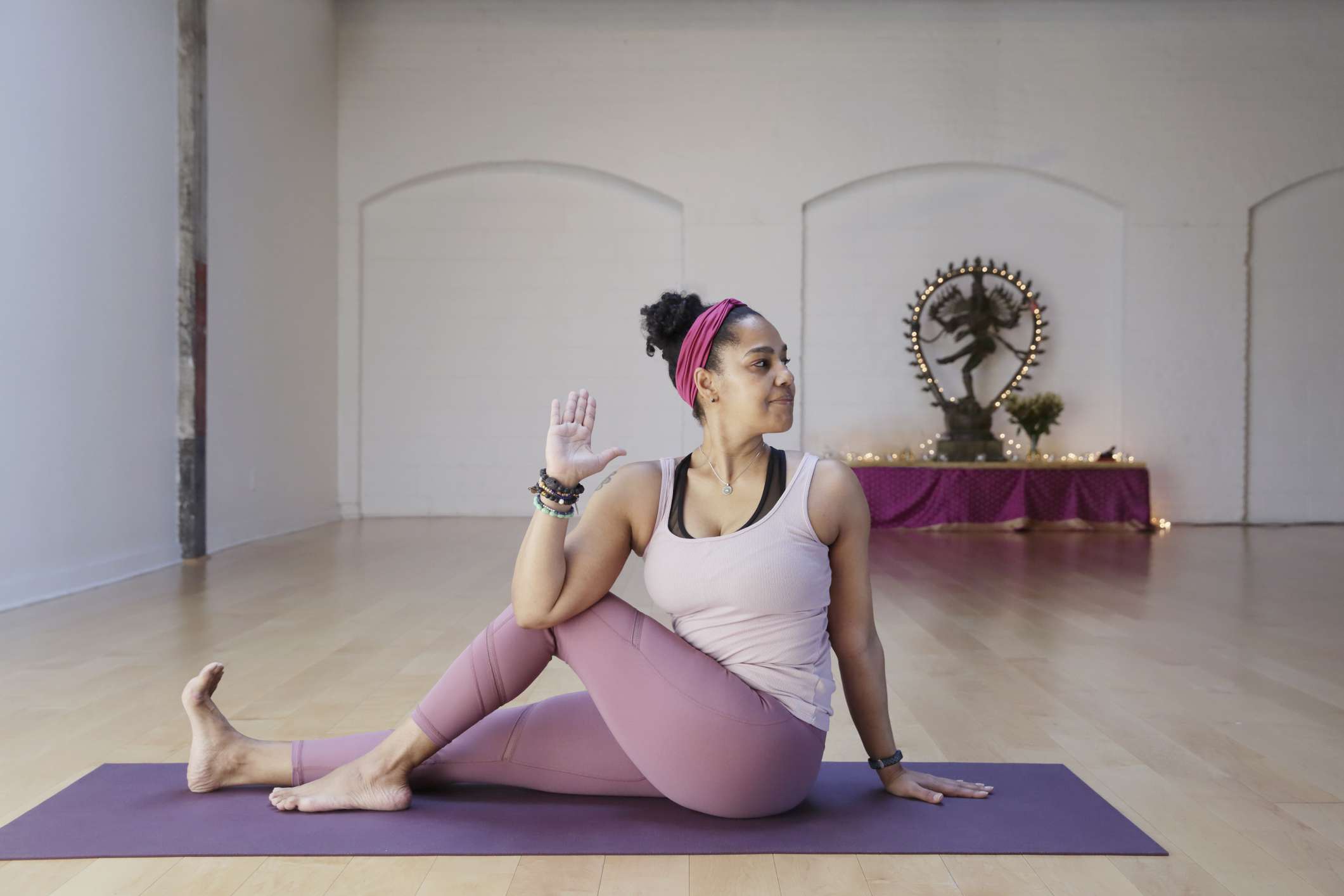Author’s Note: Nicole is a fourth-year doctoral student trainee at Nova Southeastern University. In addition, Nicole is a 200 HR yoga teacher, who is also certified in kid’s yoga and Antigravity yoga (Fun 1 & 2). After three years of working with women with a history of trauma, it became apparent that discomfort associated connecting to the body was the rule, rather than the exception with most clients. Consequently, she became curious into how yoga may be beneficial to these women, especially when previous treatment episodes had been unsuccessful. Following her yoga teacher training, Nicole began to teach yoga at the Therapeutic Oasis in Delray Beach, Florida, where she taught trauma-informed one-on-one yoga sessions to clients with a history of trauma. Although not always employing physical yoga postures into the therapy session, Nicole has observed multiple successes in reducing the presence of dissociative symptoms and improving emotion regulation and distress tolerance skills through the grounding effects of breath work and slight physical movements.
The benefits of cardiovascular exercise in improving physical and mental health have been known for several decades (e.g., Szbadi, 1988). More recently, the positive effects of yoga (a form of exercise that incorporates cardio) on disorders such as anxiety, depression, and other mental and physical conditions have been examined (e.g., Büssing, et al., 2012), particularly given its strong connection with mindfulness meditation, also a “hot topic” in the field of psychology.
What is Yoga?
Yoga, meaning “union,” has traditionally been associated with a mental practice aimed to achieve greater consciousness through the use of meditation and physical postures (Satchidananda, 1990). As yoga has gained increased popularity in the Western world, individuals have been driven to yoga for various reasons, often because it fosters and encourages relaxation, increased bodily strength and flexibility, and experiential presence in the current moment (i.e., mindfulness).
Multiple schools of yoga exist (e.g., vinyasa, hatha, Iyengar, Bikram, etc.), with varying emphases on breathing, meditation, postures, and strength. Each school attracts a unique type of yoga student, depending upon their goals for their practice. This may prove similar to clients seeking out varying types or orientations of therapy, depending upon their treatment goals.
Yoga is a Practice
Importantly, yoga is referred to as a practice. That is, with the exception of entering and exiting various postures in a way that avoids injury; a posture may look different from one body to the next and still be “correct.” Novice yogis often assume that if they are inflexible, then they will be unable to reap the full benefits of yoga, but it is the stretch that is most important, not flexibility. In fact, for the super bendy, the full experience of the stretch may be lost. For these individuals, there may be an added benefit to resisting the body’s natural proclivity to collapse into a certain pose.
Finding Your Edge in Yoga
Consistent with the notion that yoga is a practice, yoga classes often offer variations of each pose, thereby allowing students to choose the version that provides the appropriate challenge, referred to by many yoga teachers as “finding your edge.”
For clients, or any individual practicing yoga, the choice inherent in selecting the appropriate variation in the position provides a sense of freedom of expression and control.
Similarly, the ability to find one’s edge allows for the implementation of distress tolerance skills through the acknowledgment that a posture need only be held for a specified duration of breaths or time. This may be bolstered by the influence of Eastern philosophy in Linehan’s development of Dialectical Behavior Therapy (DBT; Linehan, 2015).
Yoga in the Therapy Room
Within the therapy context, adjunctive treatments such as yoga may provide additional improvements beyond traditional therapy alone. Incorporating yoga into treatment integrates both mind and body, creating a more holistic healing process through the teaching of mindfulness and improving client’s connectedness and awareness to their internal experience. That is, the implementation of yoga both with and without concurrent therapy, facilitates experiencing the present moment, making choices, taking effective action, and creating a moving meditation (Emerson, et al., 2011). Given the potential benefits of yoga, therapists may be interested in how yoga can be implemented into the therapy session, without requiring a personal yoga practice or completion of a yoga teacher training.
For Whom Might Yoga Be Useful to Incorporate in Therapy?
- Clients who report dissociation
- Clients who report anxiety in or outside of session (e.g., normal fidgeting up to a panic attack)
- Clients whose body language indicates guardedness (e.g., arms folded)
- Clients who report disordered eating or eating disorders
- Clients who endorse a history of prolonged abuse and/or trauma exposure
- Clients who struggle to establish rapport
- Clients who report maladaptive thoughts (e.g., “I can’t do anything right”)
- Clients who lack self-esteem
Why Does Yoga Work?
- Fosters experiential presence
- Allows clients to focus on bodily cues
- Provides an opportunity for the client to exercise choice
- Bestows a sense of self-efficacy and empowerment over one’s body, thoughts, and actions
- Provides a way for the therapist to experientially join the client in session
5 Ways to Implement Yoga in Therapy Sessions
Below are 5 ways of implementing yoga into the therapy session. Remember, these are techniques to act as a foundation, and should be modified or adapted to your client’s unique individual needs. Much like meditation, there is no “wrong” way to do these techniques:
1. Alternate nostril breathing
How to do it:
Instruct the client to place their index finger on their forehead and rest their thumb and middle finger on either side of their nostrils.
Instruct the client to inhale through the right nostril while gently closing off the left nostril, then alternate their fingers to exhale out of the other nostril.
The therapist can continue with this pattern or instruct the client to complete multiple rounds of breathing with each nostril, prior to alternating in an effort to ensure that the client is present.
Why does it work?
Alternate nostril breathing encourages presence in that the client is listening to the instructions of the therapist regarding from which nostril they should be inhaling into or exhaling out from. This reduces the likelihood of engaging in rumination, as it can become difficult to breath without adhering to the instructions.
Additionally, the idea with this breathing technique is to pace the breathing, which can facilitate in emotion regulation. Clients may wish to discuss their experiences following the exercise, as with any of the following exercises, identifying aspects that worked well or did not adhere to their expectations, while problem-solving or troubleshooting modifications (e.g., only inhaling through the right nostril, closing off both nostrils to hold in the inhalation, exhaling out of both nostrils).
The following four ways of implementing yoga into the therapy session include physical movement. With each of the following movement sequences, inhalations and exhalations should be through the nose and clients should be encouraged to breathe into the diaphragm, allowing their belly to expand outward, rather than breathing into the chest. The physical movements serve to draw the client’s attention to both their breath and the sensations within their body (e.g., expansion of the chest, stretching of the back, twisting of torso) and may also promote relaxation. As is common in vinyasa yoga, where each movement is associated with either an inhalation or exhalation, this facilitates establishing a moving meditation and promotes relaxation and mindfulness.
Disclaimer: Before engaging in any of the physical techniques, clients should be asked about any preexisting medical conditions, and approval should be obtained from a medical professional as to whether or not it is safe for the client to engage in mild exercise. Although there is no “wrong” way to participate in these exercises, clients should be aware that with any physical exercise, injury is always possible and that they should never force their bodies to move in a certain way, or continue with any exercise if it is uncomfortable. Clients should be referred to their physicians, should there be any concerns.
2. Seated cat-cow
How to do it:
The client sits towards the edge of the seat with both feet placed on the floor and with hands resting on the knees.
The client inhales through the nose, arching the spine and lifting the chin towards the sky; and exhales through the nose tucking the chin towards the chest and rounding the spine.
Encourage clients to notice how the movements of the spine can move in both directions, while guided by their breath. Complete several cycles of this.
Why does it work?
The seated cat-cow sequence serves to direct the client’s attention to the movements of the spine. It encourages expansion of the chest and rounding of the spine. Chest expansion may contribute to feelings of vulnerability in some clients, but encourages a depth of breath and openness. This may produce emotional distress in clients with low self-esteem, feelings of unworthiness, or fear of taking up physical space within their bodies. However, with appropriate use of distress tolerance skills and with continued practice, clients can find feelings of safety and comfort in their bodies.
3. Seated twist
How to do it:
The client sits with both feet placed on the floor. The client is asked to inhale through the nose, raising the arms from alongside of the body over the head, as if they are drawing a circle with their arms.
Throughout this sequence, the client should keep the shoulders down, and resist them from reaching up towards the ears. As the client exhales through the nose, the client twists their torso to the right, reaching for the back of the chair with the right hand, placing the left hand to the outside of the right knee, and looking over the right shoulder.
On the next inhalation, the client raises their arms back overhead while returning their torso to center. On the subsequent exhalation, the client twists their torso to the left with the left arm reaching to the back of the chair, the right arm resting on the left knee, and gazing over the left shoulder.
To complete one full cycle, the client inhales back to center with arms raised overhead. If the client is comfortable maintaining the twisted position, you can encourage them to hold the twist, lengthening the spine on the inhalation and relaxing deeper into the twist on the exhalation.
Complete several cycles of this.
Why does it work?
The seated twist sequence serves to direct the client’s attention to the movements of the spine and the twisting of the torso. Clients may also notice a contraction of the oblique muscles and spine on the twist. Holding the twisted position can provide clients with the opportunity to be mindful of their breath and their ability to create and take up space within the body. Due to a sense of compression during the twist, the client may have to be particularly aware of their breath in order to find space for the subsequent inhalation. In linking breath to movement and creating a flow, clients may be able to create a moving meditation.
4. Seated forward fold
How to do it:
The client sits comfortable on the chair. On the inhalation in through the nose, the arms are raised up overhead.
When the client exhales out through the nose, they should extend forward from the waist allowing the torso to fall forward onto the thighs, allowing the head and arms to hang heavy towards the floor.
Inhale back to sitting upright and repeat as many cycles as desired.
Why does it work?
This position allows for a spinal extension from the waist, while allowing clients to observe the points of contact between the upper body and their thighs upon folding, similar to engaging in a physical grounding technique. This can serve to reinforce the mindfulness “observe” skill. Additionally, the seated forward fold may increase the activation of the parasympathetic nervous system in a way that is similar to the dive reflex, without the use of cold water as described in the “tipping the temperature” component of the TIP skill as outlined in the DBT manual (Linehan, 2015). Consequently, this pose can also facilitate in relaxation and may increase a sense of calm.
5. Mountain pose
How to do it:
The client stands with arms down by their side, palms facing out. The client should practice balancing their weight evenly between both feet, while imagining that a thread is attached to the top of their head, pulling them upwards and elongating the spine.
For an added grounding component, the client can practice shifting their weight from one foot to the other or shift their attention to the rise and fall of their abdomen while breathing. Clients should be encouraged to relax their shoulders down and back and contract their abdominal muscles while tucking their pelvis slightly.
Why does it work?
This postures serves to encourage physical grounding and can incorporate other aspects of physical grounding techniques, such as describing what the clients see in their environment, feel within their bodies, etc. Standing at attention can also encourage increased comfort at taking up space within their bodies.
Additional Techniques to Engage Clients in Yoga within the Therapy Session
We would also recommend providing psychoeducation before initiating these interventions to explain how a focus on the present moment can improve emotion regulation while reducing the tendency to avoid uncomfortable stimuli (van der Kolk, et al., 2014). Likewise, mind-body interventions, such as yoga can facilitate with bodily awareness, a lack of which has been associated with dissociation (Price & Thompson, 2007). Additionally, yoga may improve clients’ abilities to implement distress tolerance skills, which can facilitate clients’ acceptance of current situations. The importance of mindfulness and distress tolerance as offered through yoga is bolstered by the empirically validated Dialectical Behavioral Therapy treatment approach, which has adopted aspects of Eastern philosophy (Linehan, 2015).
Lastly, yoga practice has demonstrated neurological implications, such as alterations in sympathetic and parasympathetic nervous system responses (as cited in Mitchell et al., 2014), muscle strength, blood pressure, improvements in arousal regulation, among other physiological and neurological changes (as cited in van der Kolk, et al., 2014). These changes may decrease reactivity to minor stressors, which previously may have been responded to as threats to the individuals’ safety. In addition to improving survivors’ level of arousal to various stimuli, these neurological changes may reduce dissociation.
To increase the client’s comfort in engaging in any of the abovementioned techniques, offer to participate with them. This will serve as an opportunity to model the technique and can reinforce the therapeutic alliance by sharing in the exercises. Moreover, it may be beneficial to discuss with the client ways to apply the skills outside of session, so that they may be added to the client’s repertoire of effective coping strategies.



